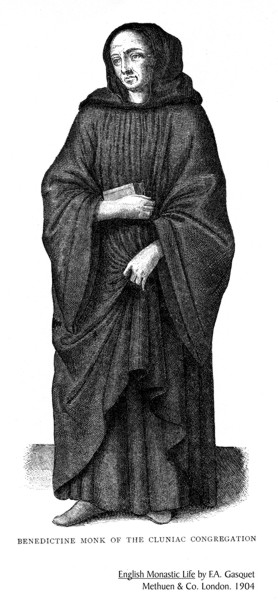|
St. Berno reformed the
Benedictine Rule and created the Cluniac Order in the tenth
century, co-founding a monastery at Cluny (in Saône-et-Loire,
Bourgogne, France), from which the
order takes its name. The Cluniac Order became extraordinarily
rich and powerful, and is still active today. On this page you
will
find links to some of this information, as well as information from
Abbot
Gasquet's book English
Monastic
Life. Gasquet published the book through The Antiquaries
Book
series in
1904. It is now out of print and not generally available.
There may
be a number of factual errors in the text, or points on which
historians or theologians do not agree. Gasquet's
text, notes & links>>
|
 |
| Cluniacs
The Cluniac
adaptation of the Benedictine Rule took its rise
in A.D. 912 with Berno, abbot of Gigny.
With the assistance of the Duke of Aquitaine he
built and endowed a
monastery at Cluny, near
Macon-sur-Saone. The Cluniac was a new
departure in monastic government. Hitherto the monastery was
practically
self-centered ; any connection with other religious houses was at most
voluntary, and any bond of union that may have existed, was of the most
loose
description. The ideals upon which Cluny
was established was the existence of a great central monastery with
dependencies spread over many lands, and forming a vast feudal
hierarchy of
subordinate establishments with the closest dependence on the
mother-house. Moreover, the superior of
each of the dependent monasteries, no matter how large and important,
was not
the elect of the community, but the nominee of the abbot of Cluny ; and in the same way the profession of every
member of the congregation was made in his home and with his sanction. It was a great ideals ; and
for two centuries the abbots of Cluny
form a dynasty worthy of so lofty a position. The
first Cluniac house founded in England
was that of Barnstable. This was speedily followed by that of Lewes,
a priory set up by William, earl of Warren,
in A.D. 1077, eleven years only after the Conquest. The last was that of Stonesgate, in Essex,
made almost exactly a century later. On
account of their dependence upon the abbot of Cluny,
several of the lesser house were suppressed as “alien priories” towards
the
close of the fourteenth century, and those that remained gradually
freed
themselves from their obedience to the foreign superior.
At the time of the general suppression in the
sixteenth century there were thirty-two Cluniac houses ‘one only,
Bermondsey,
was an abbey ; the rest were priories, of which the most important was
that
which had been nearly the first in order of time, Lewes.
English Monastic Life by
F.A. Gasquet. (pages 217-218)
|
Cluniac Houses in England (see
Religious Houses index page):
| Barnstaple |
Priory
|
|
Devon.
|
Bermondsey
fd.1082 ds. 1538
|
Abbey
|
(cell
to Charité-sur-Loire,
France)
|
Surrey.
|
| Bromholm |
Priory
|
|
Norfolk.
|
Carswell
|
|
(cell
to
Montacute) |
Devon.
|
| Castleacre |
Priory
|
|
Norfolk.
|
Clifford
|
Priory
|
|
Hereford.
|
St.
Cyrus
|
|
(cell
to
Montacute) |
Cornwall.
|
| Daventry |
Priory
|
|
Northants.
|
Dudley
|
|
(cell
to Wenlock) |
Stafford,
|
| Farleigh,
or Farley |
|
|
Wilts.
|
| Heacham,
or Hitcham |
|
(cell
of Lewes)
|
Norfolk.
|
St.
Helen'
|
|
|
Isle
of
Wright. |
Holme
|
|
(cell
to Montacute) |
Dorset.
|
| Horkesley
Parva |
Priory
|
|
Essex.
|
| Horton,
Monks (or
Monks Horton) |
|
(cell
to Lewes)
|
Kent.
|
Kershall
|
|
(cell
to Lenton) |
Lancaster.
|
Lenton
|
Priory
|
|
Notts.
|
Lewes
|
Priory
|
|
Sussex.
|
Malpas
|
|
(cell
to Montacute) |
Monmouth.
|
Mendam
|
|
|
Suffolk.
|
| Monk
Bretton |
Priory
|
|
Yorks.
|
Montacute
|
Priory
|
|
Somerset
|
Northampton,
St.
Andew's
|
Priory
|
|
Northants.
|
Pontefract
|
|
|
Yorks.
WR
|
| Preston
Capes |
|
(translated
to Daventry) |
Northampton. |
| Prittlewell,
or
Pipwell |
Priory |
|
Essex. |
| Slevesholme,
or
Methwold |
|
(cell
of
Castleacre) |
Norfolk.
|
| Stanesgate |
|
(cell
to Lewes) |
Essex. |
| Stow |
|
(cell
of Castleacre) |
Norfolk |
| Thetford |
Priory |
|
Norfolk. |
| Thetford |
|
|
Norfolk.
|
| Wangford |
Priory |
|
Suffolk. |
| Wenlock |
Priory |
|
Salop. |
| Arthington |
|
Female
House (Nuns)
|
Yorks.
|
| Northhampton,
De La
Pré |
|
Female
House (Nuns)
|
Northants. |
|
Cluniac Links:
An article on the Cluniac Order
though the Order of Saint Benedict homepage.
Corrections,
questions?  |
|
Historyfish
pages, content, and design copyright (c) Richenda
Fairhurst, 2008
All rights reserved. No commercial permissions are
granted.
The Historyfish site, as a
particular and so
unique "expression," is copyright. However, some (most) source
material is part of the public domain, and so free of copyright
restrictions. Where those sections are not clearly marked, please
contact me so I can assist in identifying and separating that material
from the Historyfish site as a whole.
When using material from this site,
please keep
author, source, and
copyright permissions with this article.
Historyfish intends to generate discussion
through shared
information and does not claim to provide,
in any way, formal, legal, or factual advice or information. These
pages are opinion only. Opinions shared on historyfish are
not necessarily
the
opinions of historyfish editors, staff, owners or
administrators. Always consult
proper authorities with questions pertaining to copyrights, property
rights, and intellectual property rights.
It is my intent to follow copyright law (however
impossibly convoluted
that may be). Please contact me should any material included here be
copyright protected and posted in error. I will remove it from the
site. Thank you. |
|
